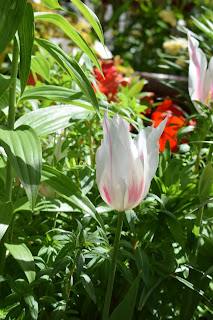It's been a case of start then stop with our weather this month but it looks as if we've finally turned the corner. At least here in Oakland. Today's blog has lots of photos but before we get to those I want to encourage everyone to visit their local botanical garden. Whether that's UC Botanic Garden or the Regional Parks Bot Garden (formerly Tilden Bot Garden) or the small but charming Lakeside Botanic Garden, all in the East Bay, or the SF Botanic Garden (Strybing), this is the perfect time to check out the glories of these botanic gardens.
Okay, here are the photos.
The photos above and below are of my wonderful Tulip Apricot Parrot. I've never had luck with parrot tulips before so maybe it's just that I bought them from the excellent Tulip World.
There are many kinds of tulips and the one you see here is a Lily flowering kind. Notice the tapered petals that are indicative of this group. Very pretty.
Cistus McGuire's Gold. It took four years to initially flower but this rockrose now blooms faithfully every year.
Aloe striata (Coral aloe). Three bloom spikes this year and as I've mentioned, a great plant for attracting hummingbirds to your garden.
Layia platyglossa. Tidy Tips as they are commonly called are prolific bloomers and a good native annual for attracting bees and butterflies.
Scabiosa Harlequin. Though we normally don't think of Pincushion flower plants as ground covers, this variety has stayed low and blanketed the lower portion of my walkway bed.
Babiana stricta hybrids. It's been a great year for my Babianas. Though the flowers are mostly purple, there are some hot pink ones too.
Calceolaria Tiger Balloon. A lot of Calceolarias are annuals but this guy is back for its third year this spring.
One last shot of my species Gladiolus, G. Nathalie.
I planted violas on top of two rectangular planters containing daffodils, lilies and species glads and it worked out very well.
Dutch iris come in quite a range of colors but I'll admit that my favorites are the golds, gingers and dark reds.
This Campanula Blue Waterfall is the most prolific bloomer of all the varieties I've come across and just needs trimming back in the winter in order to freshen it up for the next year's blooms.
Choisya Sundance. The golden-leaved version of Mock Orange is lovely just for its foliage but the white flowers offer just as much of a heady fragrance as the straight species (Choisya ternata).
Most of us are familiar with dogwood flowers but hold on, this variety (Cornus florida Urbiniana) has slender white petals that loop back till they touch each other in the center. Fabulous!
My Japanese Lace fern has become my favorite fern (among the 20+ I have in the garden). I just love the look of it and it has proved durable.
Begonia Gene Daniels. Notable for its huge kidney-shaped leaves and their glowing red backsides.
Phacelias (Desert bluebells) are one of my favorite California native annuals and this one (P. campanularia) has the deepest blue flowers of the various members of this genus.
More Dutch iris. Tis the season....
Leucospermum Veldfire. I've taken many photos of this Protea family member but the flowers are just so eye-popping I can't help myself.
Phlomis fruticosa. A hardy sage relative, this guy produces joyful yellow flowers all summer long.
Snapdragons. Great for a splash of color wherever you want it.
Ditto for Million Bells (Calibrachoa). This one is newly planted so hasn't begun to trail yet.
I kind of think of tiny new Cotinus leaves as being like little flames dancing in the sun. Very pretty.
A closer shot of my Lily-flowering tulip.
Here's a shot of the east side of my Woodland bed. Those are Douglas iris on tall stems and the little nodding blue flowers are Scilla Excelsior.
Another shot of that low growing Scabiosa Harlequin. Of course they are famous for attracting butterflies but the flowers are popular with bees too.




























No comments:
Post a Comment